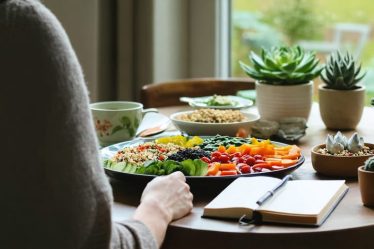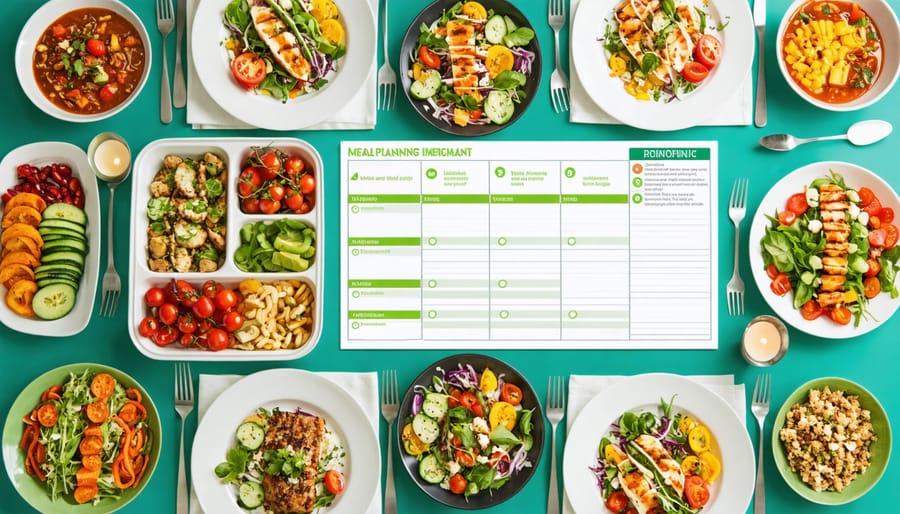
Transform your plate into a powerful force for environmental change by making sustainable eating your daily superpower. Every bite we take has the potential to shape not just our health, but the future of our planet. The good news? Making earth-friendly food choices doesn’t mean sacrificing flavor or breaking the bank.
Think of sustainable eating as a delicious adventure rather than a restrictive diet. From choosing locally grown produce bursting with seasonal flavors to discovering plant-based proteins that excite your taste buds, these choices create ripples of positive impact. When you opt for package-free products at your local farmer’s market or grow fresh herbs on your windowsill, you’re not just preparing meals – you’re participating in a global movement toward a healthier planet.
The beauty of sustainable eating lies in its simplicity: start small, think local, and let your food choices tell a story of conscious living. Whether you’re a busy parent, a career professional, or someone just beginning their eco-friendly journey, there’s a sustainable eating strategy that fits your lifestyle. Ready to make every meal count? Let’s explore how your kitchen can become a hub for positive environmental change, one delicious decision at a time.
Small Changes, Big Impact: Starting Your Sustainable Food Journey
Kitchen Habits That Make a Difference
Let’s talk about those little kitchen habits that can make a big impact on our planet! I discovered that implementing simple zero-waste kitchen habits not only helps the environment but also saves money in the long run.
Start by keeping a “first in, first out” system in your fridge – move older items to the front so they don’t get forgotten. I love using clear containers to store leftovers; it’s amazing how much more likely you are to use food when you can actually see it!
Get creative with scraps: vegetable peels and ends make fantastic stock, while citrus peels can be dried for tea or zested for extra flavor. Keep a container in your freezer for these odds and ends until you’re ready to use them.
Planning meals ahead has been a game-changer for my family. We make a weekly menu and shopping list, which helps prevent overbuying and reduces those emergency takeout nights. When prepping ingredients, think about how to use the entire item – those carrot tops can become pesto, and bread ends make perfect croutons.
Store your produce properly to extend its life. Did you know that keeping herbs in water, like flowers in a vase, helps them last longer? Or that ripening fruits should be kept separate from other produce? These simple storage tweaks can add days to your food’s freshness.
Remember, sustainable eating isn’t about perfection – it’s about progress. Start with one or two of these habits and build from there.
Smart Shopping for Planet-Friendly Foods
Shopping sustainably doesn’t have to be overwhelming or expensive – I’ve learned this firsthand through years of mindful grocery shopping! Let me share some of my favorite budget-friendly tips that help both the planet and your wallet.
Start by becoming friends with the seasonal produce section. I’ve noticed that in-season fruits and vegetables are usually cheaper and travel shorter distances to reach our stores. Plus, they taste so much better! I love checking out local farmers’ markets, where I often find great deals on fresh, package-free produce.
When it comes to packaged foods, I’ve developed a quick label-scanning strategy. Look for items with minimal packaging and recyclable materials. Many budget-friendly staples like beans, grains, and nuts are available in bulk bins, allowing you to buy exactly what you need while reducing plastic waste.
One game-changer for me was planning meals around plant-based proteins. Items like lentils, chickpeas, and tofu are typically less expensive than meat and have a smaller environmental footprint. I was surprised to discover how versatile these ingredients can be!
Don’t feel pressured to buy everything organic – focus on the items where it matters most, like the “dirty dozen” produce items. For everything else, conventional options are perfectly fine. Remember, small changes add up to make a big difference. Start with what feels manageable for your lifestyle and budget, and build from there.
Seasonal Eating Made Simple
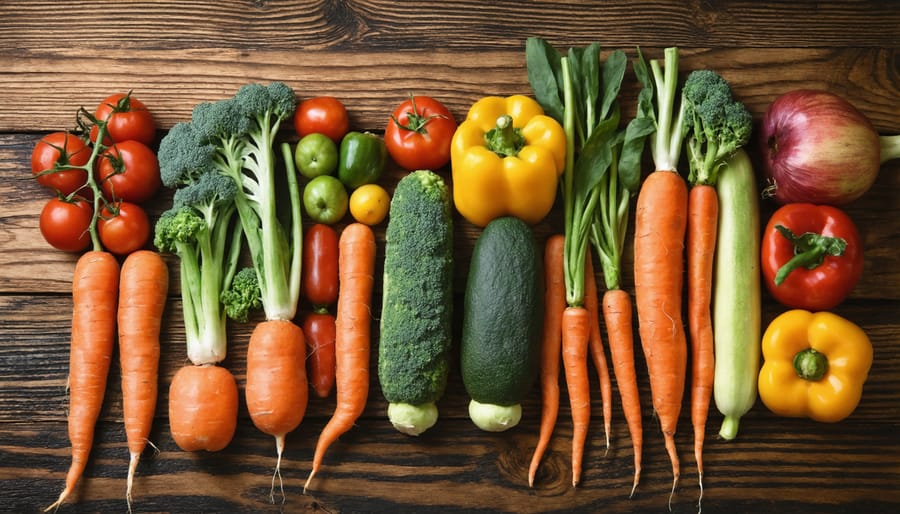
Your Seasonal Food Calendar
Getting in tune with nature’s rhythm not only helps our planet but also ensures you’re enjoying produce at its peak flavor and nutritional value. I’ve found that following a seasonal food calendar makes meal planning both exciting and eco-friendly! Let me share some seasonal sourcing tips that have transformed my kitchen.
Spring brings tender asparagus, fresh peas, and vibrant strawberries. Summer overflows with juicy tomatoes, sweet corn, and colorful bell peppers. As autumn rolls in, embrace hearty squashes, crisp apples, and nutrient-rich root vegetables. Winter offers citrus fruits, hardy greens like kale, and Brussels sprouts.
Pro tip: Create a simple chart for your fridge, marking each month with its star ingredients. I’ve found this especially helpful when shopping at farmers’ markets or planning weekly menus. Remember that seasonal variations might differ slightly depending on your location, so connecting with local farmers and markets is a great way to stay informed about what’s truly in season in your area.
Finding Local Food Sources
One of my favorite weekend rituals is visiting our local farmers’ market, where I’ve built wonderful relationships with the farmers who grow our food. Finding local food sources isn’t just about fresh produce – it’s about connecting with your community and understanding where your food comes from.
Start by exploring farmers’ markets in your area. Most cities have at least one weekly market, and many now operate year-round. These vibrant community spaces offer seasonal produce, locally raised meats, and artisanal products. Don’t be shy about chatting with vendors – they love sharing stories about their farming practices and offering cooking tips!
Consider joining a CSA (Community Supported Agriculture) program, where you receive regular boxes of seasonal produce directly from local farms. It’s like having your own personal farmer, and it’s a wonderful way to try new vegetables and support sustainable agriculture.
Many areas also have food co-ops or specialty stores that prioritize local products. Check their bulletin boards – they often post information about nearby farms and food events. Social media can be helpful too; following local farmers and food activists on Instagram or Facebook keeps you informed about seasonal offerings and special events.
For those tight on time, many farmers now offer direct-to-consumer delivery services or participate in online marketplaces. Some even host farm visits or harvest days, which can be a fantastic way to connect with your food source and create memorable family experiences.
Meal Planning for Sustainability
Weekly Planning Templates
Let’s make sustainable eating a breeze with some practical weekly planning tools! I’ve found that having a solid template makes all the difference in sticking to effective meal prep strategies while keeping our environmental impact in mind.
Start with a simple weekly grid that includes breakfast, lunch, and dinner columns. Add a fourth column for your shopping list, which you’ll fill in as you plan. Here’s my favorite approach: designate Sundays for planning and prep, focusing on seasonal produce available at your local farmers’ market.
Create a rotating menu of sustainable staples – think whole grains, legumes, and seasonal vegetables. Plan to use ingredients across multiple meals to minimize waste. For example, roasted vegetables can star in Monday’s dinner and Tuesday’s lunch wrap.
Pro tip: Include a “leftovers day” in your weekly plan. This not only reduces food waste but also gives you a break from cooking! Keep a notes section in your template to track which meals were hits with your family and any adjustments needed for next time.
Want to make it even easier? Download my free sustainable meal planning template from the resources section below. It includes space for ingredient lists, prep notes, and a waste-tracking column to help you monitor your progress toward more sustainable eating habits.
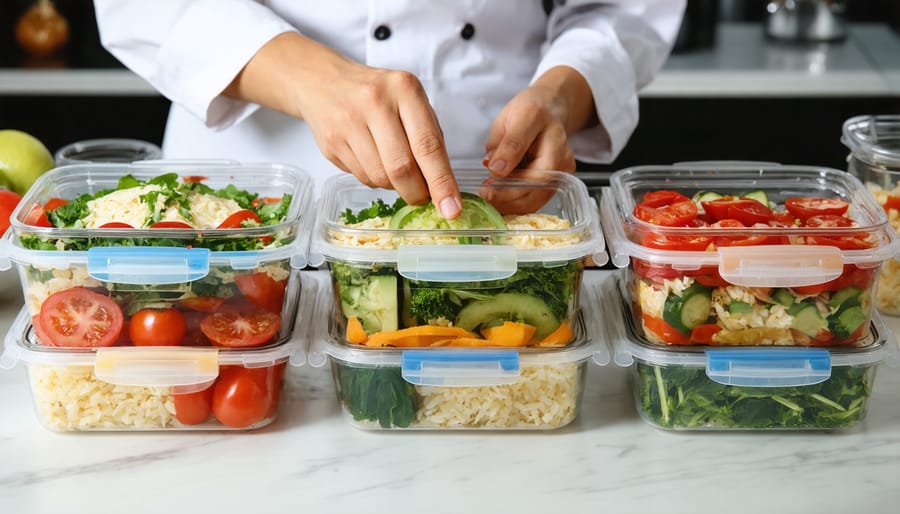
Making the Most of Leftovers
Remember that time when you made a big batch of roasted vegetables, only to find them forgotten in the back of your fridge a week later? We’ve all been there! But transforming leftovers into exciting new meals is easier than you might think, and it’s a fantastic way to reduce food waste while saving money.
Let’s start with basics: that container of plain rice from yesterday’s dinner can become a delicious stir-fry with the addition of some vegetables and sauce. Those roasted vegetables? Blend them into a creamy soup, toss them into a frittata, or use them as pizza toppings. Even day-old bread has endless possibilities – think homemade croutons, breadcrumbs, or a rustic panzanella salad.
One of my favorite tricks is the “planned leftovers” approach. When I’m cooking chicken for dinner, I deliberately make extra to use in sandwiches, salads, or wraps the next day. The same goes for grains and roasted vegetables – they’re like gold for quick lunch bowls!
Keep a designated “use first” section in your fridge for items that need to be eaten soon. Get creative with combining different leftovers – sometimes the most unexpected combinations create the most delicious meals. And remember, if you can’t use something immediately, most cooked foods freeze beautifully for future use.
These small changes in how we handle leftovers can make a big impact on both our budget and the planet.
Family-Friendly Sustainable Recipes
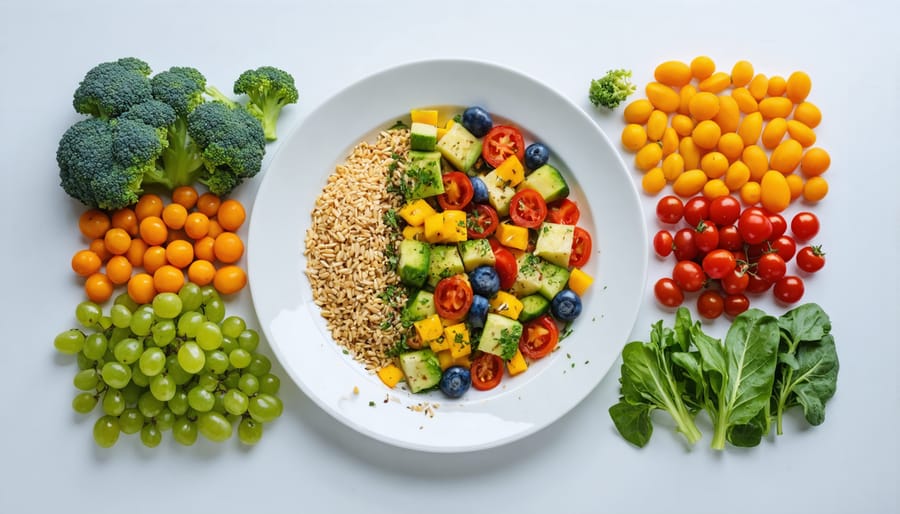
Plant-Based Favorites
Embracing plant-based cooking doesn’t mean sacrificing flavor or satisfaction. I’ve discovered some incredible plant-based meal ideas that have become family favorites in my household, converting even the most dedicated meat-lovers.
Start with a creamy mushroom and spinach pasta that’s ready in just 20 minutes. Simply sauté garlic and mushrooms, add plant-based cream (coconut milk works wonderfully), toss in fresh spinach, and serve over your favorite pasta. The earthiness of the mushrooms creates that satisfying umami flavor we all crave.
My crowd-pleasing chickpea curry is another winner. Combine chickpeas, diced tomatoes, coconut milk, and your favorite curry powder. Let it simmer while fragrant spices fill your kitchen. Serve over fluffy rice or with warm naan bread – it’s comfort food at its finest.
For something lighter, try rainbow quinoa bowls topped with roasted seasonal vegetables, avocado, and a tahini-lemon dressing. The beauty of this dish is its flexibility – use whatever vegetables you have on hand.
Don’t forget the humble lentil shepherd’s pie, topped with creamy mashed potatoes. It’s so hearty and satisfying that no one will miss the meat. The key is adding plenty of herbs and using mushrooms for that meaty texture.
These recipes prove that plant-based cooking can be both sustainable and delicious, perfect for any night of the week.
Zero-Waste Recipes
Getting creative in the kitchen isn’t just about making delicious meals – it’s also about making the most of every ingredient. I’ve discovered that some of the most satisfying recipes are those that help us reduce waste while creating wonderful dishes. Here are three of my favorite zero-waste recipes that’ll help you maximize your ingredients.
First up is Root-to-Stem Vegetable Soup. Save those carrot tops, celery leaves, and potato peels! Simmer them with vegetable scraps in water to make a flavorful stock, then add chopped vegetables, legumes, and herbs for a hearty soup. The peels add extra nutrients and depth of flavor you wouldn’t get otherwise.
Next, try Citrus-Peel Tea Cake. Instead of tossing orange or lemon peels, dry them and grind them into a powder. Mix this into your favorite tea cake recipe for an amazing aromatic boost. The oils in the peel add intense flavor and natural sweetness, reducing the need for additional sugar.
Finally, there’s Wilted Greens Pesto. Those slightly droopy spinach leaves or herb stems? Blend them with olive oil, nuts, garlic, and cheese for a versatile sauce. I love spreading it on sandwiches, tossing it with pasta, or using it as a dip for vegetables.
Remember to store these dishes in reusable containers and freeze portions you can’t eat right away. This way, you’re not just preventing food waste during preparation – you’re ensuring nothing goes to waste after cooking too!
As we wrap up our sustainable eating journey together, I hope you’re feeling inspired and empowered to make positive changes in your kitchen and beyond. Remember, sustainable eating isn’t about perfection – it’s about progress and making mindful choices that work for you and your family.
From my own experience, I started small by simply planning my meals better and reducing food waste. It was amazing to see how these little changes added up to make a real difference, not just for the environment but also for my budget and health.
The beauty of sustainable eating lies in its flexibility. Whether you’re starting with Meatless Mondays, growing your own herbs, or shopping at local farmers’ markets, every choice counts. Think of it as adding new ingredients to your lifestyle recipe – mix and match what works best for you.
I’ve seen countless readers in our community transform their relationship with food through these practices. Some have started composting, others have discovered exciting plant-based recipes their kids actually love, and many have found joy in supporting local food producers.
Ready to begin? Start with just one change this week. Maybe it’s buying seasonal produce or reducing your food waste. Whatever you choose, remember that you’re part of a growing movement of conscious consumers making our world a little better, one meal at a time. Your journey to sustainable eating starts now – and I can’t wait to hear about your success stories!



